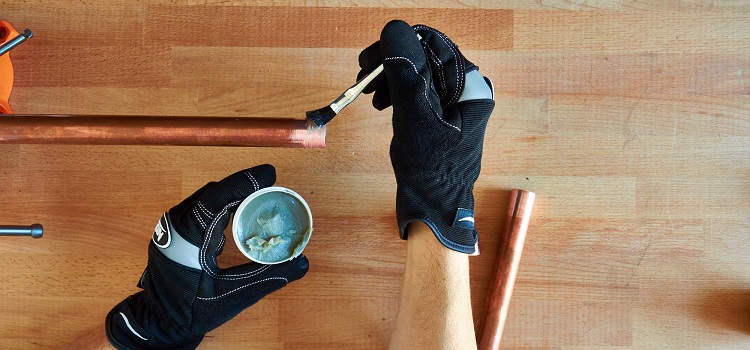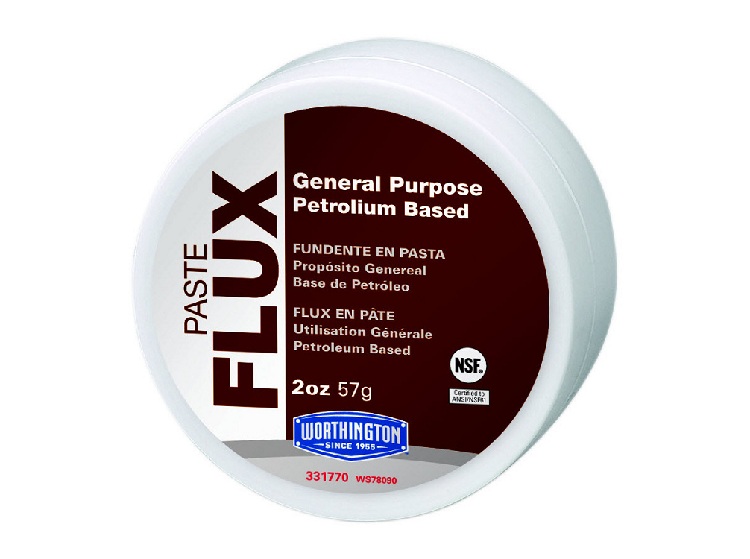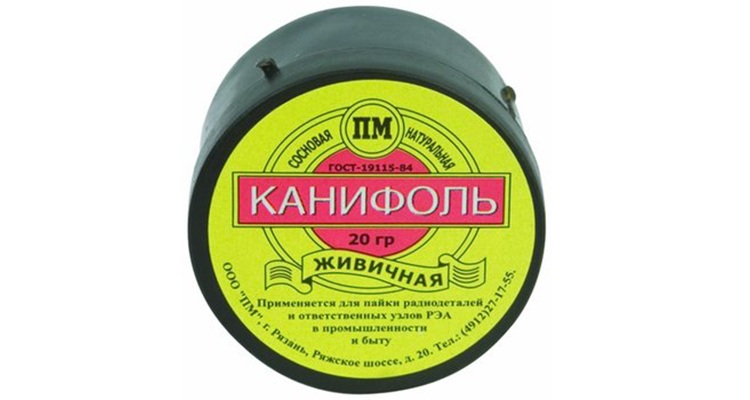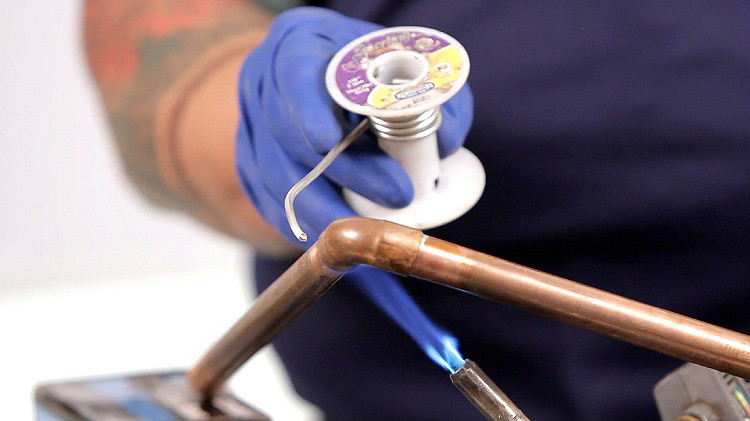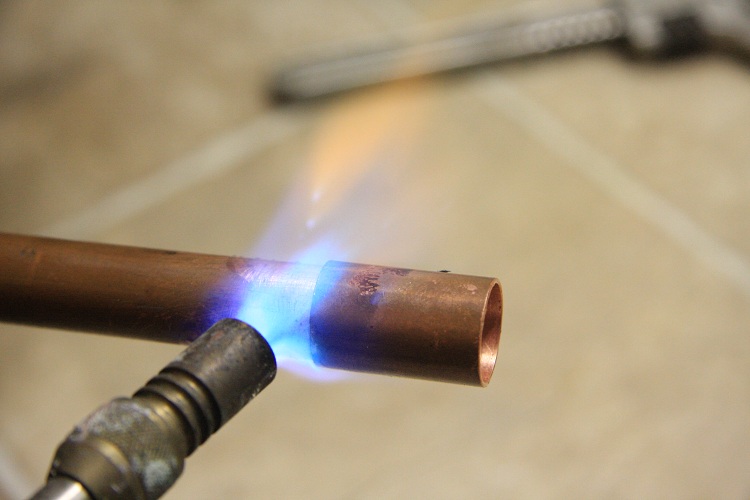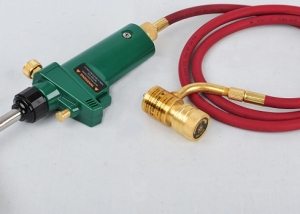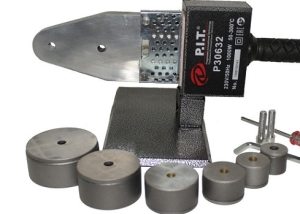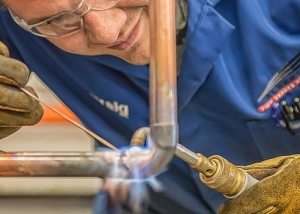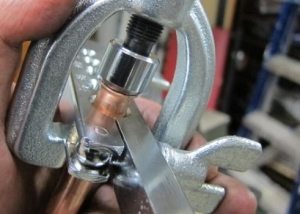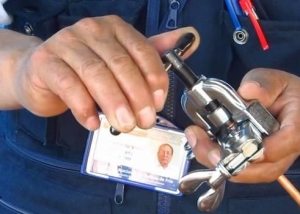Flux is a chemical substance that is used when soldering, in particular, copper pipes and helps to better fill the connecting space with solder. Also, the flux performs another very important function - it cleans a metal product from impurities and oxidation products. In addition, it forms a protective film that prevents contact of the seam with oxygen.
Content
Brazing Technology
Copper pipes are used for the installation of various communications: water, heating systems and gas pipes. They differ in a number of advantages, such as:
- Resistant to the harmful effects of corrosion;
- the surface of copper pipes is quite smooth;
- resistant to ultraviolet radiation;
- have a high coefficient of thermal conductivity;
- able to withstand high temperatures;
- have good strength;
- the service life of a copper pipeline reaches 50 years.
Note! The main disadvantage of such a pipeline is its relatively high cost, however, copper material remains popular because it is very reliable and durable.
To connect the individual elements of the copper structure using soldering. Its varieties are as follows:
- high temperature soldering;
- soldering at low temperature.
The high-temperature version of soldering is used to obtain a joint with increased strength. Low temperature soldering is used in all other cases.
Features of soldering with flux
If we compare soldering using flux and arc, in the first case, the effectiveness will be higher. The use of flux when soldering copper pipes allows the use of current with increased density. The use of high currents, in turn, affects the melting depth of the pipe. At the same time, you should not worry that the electrode will lose the coating material due to high temperatures.
The use of flux allows you to avoid a large number of foreign inclusions, since when soldering in the seam no pores are formed. Before you purchase a flux for soldering a copper pipeline, it is advisable to pay attention to its distinguishing features. For example, to exclude the possibility of the appearance of an oxide film, it is necessary to perform the following measures:
- Keep under control the soldering temperature of the soft solder for brazing copper pipes and joints to ensure the same performance. When choosing a flux, you should pay attention to its performance. This indicator depends on the type of solder.
- If it was possible to achieve temperature uniformity between the soft joint and the solder, you can use it as a device that measures the change in temperature indicators, which eliminates the possibility of overheating during soldering.
When buying the right solution for a particular case, you should pay attention to its quality.
What characteristics should a flux for brazing copper pipes have?
High-quality flux, which is used for soldering copper pipelines, must meet some requirements. Consider them:
- regardless of type, the composition should be evenly distributed over the working surface;
- the viscosity and density of this substance should be less than that of solder. This is necessary in order for replacement to occur;
- the flux should dissolve the oxide film and prevent re-oxidation of the copper part;
- in addition, such a substance should provide a neat appearance of the seam;
- the composition should not be destroyed as a result of exposure to high temperatures;
- after soldering, an easy removal of dirt and dust;
- the flux should allow soldering in both vertical and horizontal sections.
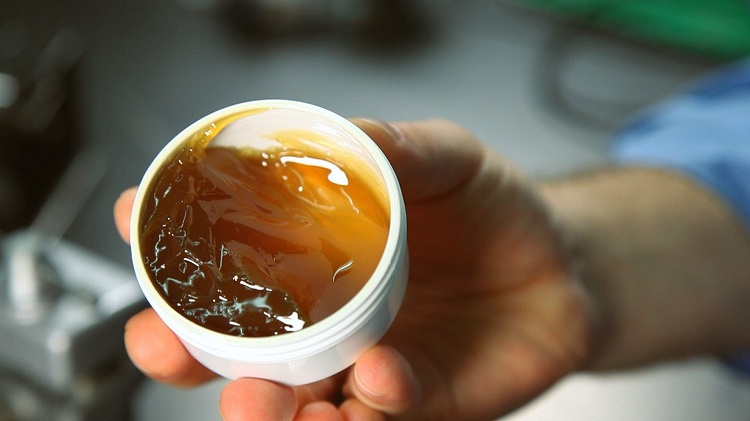
High-quality flux in the form of a paste should be viscous and dense, then it will be evenly distributed over the surface of the pipe
High-quality flux must have all of the above characteristics. After soldering, this substance is removed using special solvents.
Varieties of fluxes
All fluxes differ from each other in different indicators, but most often in the elements included in their composition. In order to clean the metal to be soldered from contaminants, the following types of fluxes are used:
- boric acid;
- zinc chloride;
- hydrochloric acid.
And to create a film that will perform protective functions, you can apply:
- rosin;
- wax;
- various pitches.
When soldering copper pipes, various types of fluxes can be used:
- liquid;
- powder;
- flux paste.
Liquid formulations are usually stored in closed tubes and used together with solders with a soft consistency. Powder fluxes are less popular due to the inconvenience associated with their use during soldering. Pastes for soldering copper pipes are more expensive, however, they are sold ready-made and their use is possible immediately. Solder paste allows you to simplify the process and get an incredibly strong and reliable adhesion of pipes.
Today, there are a huge number of varieties of this substance. However, there are three most popular types that are used for soldering, including copper pipes:
Corrosion-resistant compounds. Such substances not only perform the function of cleaning the surface from oxidation, but also remove water from the soldering place, displacing it. Using this composition allows you to not remove residues after soldering. To make such a solution at home is quite difficult.
Salicylic acid formulations. In such fluxes, the main active substance is dissolved in a composition that consists of various chemicals: alcohol, petroleum jelly (technical), gold-containing substances. Such fluxes are available only in industrial conditions and are quite popular, as they affect the quality of the seam. The seam after soldering the pipe using such a flux is very smooth.
Helpful information! Such a composition can be made with your own hands at home. As a basis, you can take tablets of acetylsalicylic acid (aspirin) and mix with technical petroleum jelly and alcohol. However, such a flux will have very little heat resistance and is more suitable for soldering various electrical equipment.
Classic rosin. When assembling pipeline communication, rosin is not used in its pure form. Most often, sodium salt is mixed with it, and as a result, a substance is obtained that has excellent protective and anti-corrosion characteristics for work with pipelines. Rosin envelops the seam with a protective film, and sodium salts interfere with oxidative processes. This composition is cheap and is the most popular today.However, this flux also has a drawback - during overheating, it can become carbonized. In addition, the joint when soldering with rosin is not as aesthetically pleasing as in the case of the flux based on salicylic acid, but it is durable and reliable.
How to solder copper pipes?
There are so many solders for connecting the individual elements of a copper pipe using soldering. All of them are divided into two types by consistency:
- solid (refractory);
- soft (fusible).
The most popular for these purposes are low temperature solders. They allow you to dock copper pipes at low temperatures, as a result of which the possibility of their deformation is excluded. But it is worth noting that the seams after such a solder have rather low mechanical qualities.
High-temperature solders, unlike low-temperature solders, allow for the most durable pipe joints.
Important! The use of high-temperature solders is recommended only to experienced professionals who know all the details of brazing copper products. An inexperienced person can simply burn a copper pipe.
For low-temperature soldering, which is very popular when installing copper pipelines in a domestic environment, solders that do not contain lead are most often used. Lead-free solders make it possible to obtain a grip resistant to mechanical stress. Lead-free solders include: alloys of tin with bismuth, antimony, silver, etc. Tin in such solders contains about 95%, the remaining 5% falls on additional elements.
For soldering at low temperatures, solder can be used, which is an alloy of tin and lead, however, such material is not recommended for installation of a water supply structure. This is due to the fact that lead is a toxic material and can harm the health of residents.
For soldering copper pipes, a special gas burner is used, which allows to achieve maximum strength and reliability of the connection.
Gas burner for connecting copper pipes
A propane burner is used to connect the individual components of copper communication and allows you to work with parts at temperatures from 550 to 2000 ° C. In addition, the design of the burner allows you to adjust the flame, depending on the type of solder (high or low temperature).
Heating of this apparatus occurs rather quickly - in 10-30 seconds. A huge advantage of such a burner is its portability. It operates without being connected to the mains, which significantly expands its capabilities.
This device is classified according to the mixture on which it works for:
- mixtures of gas with air;
- mixtures of gas with oxygen.
A mixture of gas and air is used to start household burners. Their characteristics include light weight and the same dimensions. They are used for soldering small pipe sections. And the combination of gas and oxygen allows you to work with pipes of any diameter.
Safety Rules for Soldering Copper Tubes
Soldering copper pipes involves the use of soldering equipment, which requires the necessary skills. When working with soldering equipment, pay attention to the following safety rules:
- when sealing the pipe, it is strictly forbidden to hold a segment shorter than 30 cm under the stream of flame in the hands. This is due to the fact that copper is a very good heat conductor and a burn can be obtained;
- If flux comes into contact with the skin, wash it off immediately with water. Otherwise, you can get a chemical burn;
- Carrying out the soldering process with a burner, you need to take care of your clothes - they should only be made from natural fabrics;
- Before soldering the copper pipe, care must be taken to ensure that the room is ventilated properly. This is necessary because the solder for brazing copper pipes releases harmful substances.
Brazing copper pipes
The following equipment will be required to solder the elements of the copper pipeline:
- soldering iron;
- device for cutting pipes;
- chamfer;
- special expander for pipes;
- ordinary hammer;
- yardstick.
If all the necessary tools are present, you can begin the process of soldering a copper pipeline. The work includes the following steps:
- Using a special pipe cutter, the pipes are divided into the necessary segments.
- Further, with the help of a metal brush or any other improvised device, a cleaning of the area that will be soldered is carried out.
- Then it is necessary to expand the ends of the pipes. This is done using an expander. Subsequently, these expanded ends will slide onto other pipes.
- On the edges of the pipes that will be joined, it is necessary to apply a flux.
- The end of one pipe must be inserted into the expanded end of the other.
- Use a rag or sponge to remove excess flux.
- At this stage, it is necessary to heat the connection.
Helpful information! The indicator for stopping the heating of the connection by the gas burner is the same flux - as soon as it changes its initial color to silver, heating can be completed.
- It is necessary to bring solder to the future connection. Solder, as a rule, spreads without heating using a burner, since the temperature of previously heated copper is quite sufficient. Finish work after the solder fills all the voids in the seam area.
- At the end, you need to wipe the joint with a damp cloth to remove residual solder and flux.
Soldering copper pipes is a fairly simple process, but it requires compliance with certain rules. An important point is the choice of flux and solder, the reliability of the connection depends on the quality of these materials.
